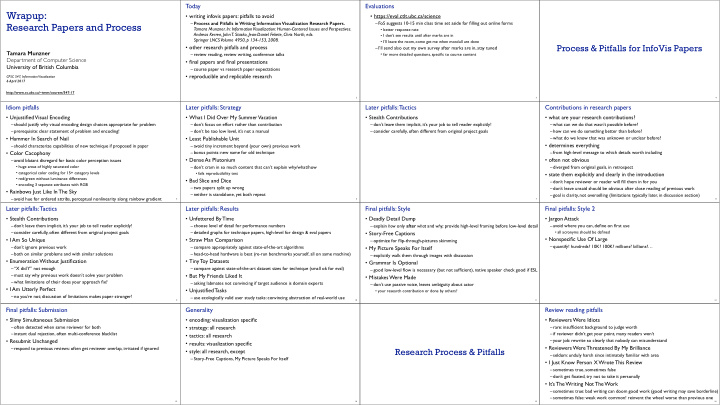



Today Evaluations Wrapup: • writing infovis papers: pitfalls to avoid • https://eval.ctlt.ubc.ca/science – Process and Pitfalls in Writing Information Visualization Research Papers. –FoS suggests 10-15 min class time set aside for filling out online forms Research Papers and Process Tamara Munzner. In: Information Visualization: Human-Centered Issues and Perspectives. • better response rate Andreas Kerren, John T. Stasko, Jean-Daniel Fekete, Chris North, eds. • I don’t see results until after marks are in Springer LNCS Volume 4950, p 134-153, 2008. • I’ll leave the room, come get me when most/all are done Process & Pitfalls for InfoVis Papers • other research pitfalls and process –I’ll send also out my own survey after marks are in, stay tuned Tamara Munzner –review reading, review writing, conference talks • far more detailed questions, specific to course content Department of Computer Science • final papers and final presentations University of British Columbia –course paper vs research paper expectations • reproducible and replicable research CPSC 547, Information Visualization 6 April 2017 http://www.cs.ubc.ca/~tmm/courses/547-17 2 3 4 Idiom pitfalls Later pitfalls: Strategy Later pitfalls: Tactics Contributions in research papers • Unjustified Visual Encoding • What I Did Over My Summer Vacation • Stealth Contributions • what are your research contributions? –should justify why visual encoding design choices appropriate for problem –don’t focus on effort rather than contribution –don’t leave them implicit, it’s your job to tell reader explicitly! –what can we do that wasn’t possible before? –prerequisite: clear statement of problem and encoding! –don’t be too low level, it’s not a manual –consider carefully, often different from original project goals –how can we do something better than before? • Hammer In Search of Nail • Least Publishable Unit –what do we know that was unknown or unclear before? • determines everything –should characterize capabilities of new technique if proposed in paper –avoid tiny increment beyond (your own) previous work • Color Cacophony –bonus points: new name for old technique –from high-level message to which details worth including • Dense As Plutonium • often not obvious –avoid blatant disregard for basic color perception issues • huge areas of highly saturated color –don’t cram in so much content that can’t explain why/what/how –diverged from original goals, in retrospect • categorical color coding for 15+ category levels • fails reproducibility test • state them explicitly and clearly in the introduction • red/green without luminance differences • Bad Slice and Dice –don’t hope reviewer or reader will fill them in for you • encoding 3 separate attributes with RGB –two papers split up wrong –don’t leave unsaid should be obvious after close reading of previous work • Rainbows Just Like In The Sky –neither is standalone, yet both repeat –goal is clarity, not overselling (limitations typically later, in discussion section) –avoid hue for ordered attribs, perceptual nonlinearity along rainbow gradient 5 6 7 8 Later pitfalls: Tactics Later pitfalls: Results Final pitfalls: Style Final pitfalls: Style 2 • Stealth Contributions • Unfettered By Time • Deadly Detail Dump • Jargon Attack –don’t leave them implicit, it’s your job to tell reader explicitly! –choose level of detail for performance numbers –explain how only after what and why; provide high-level framing before low-level detail –avoid where you can, define on first use –consider carefully, often different from original project goals –detailed graphs for technique papers, high-level for design & eval papers • all acronyms should be defined • Story-Free Captions • Nonspecific Use Of Large • I Am So Unique • Straw Man Comparison –optimize for flip-through-pictures skimming –quantify! hundreds? 10K? 100K? millions? billions?… –don’t ignore previous work –compare appropriately against state-of-the-art algorithms • My Picture Speaks For Itself –both on similar problems and with similar solutions –head-to-head hardware is best (re-run benchmarks yourself, all on same machine) –explicitly walk them through images with discussion • Enumeration Without Justification • Tiny Toy Datasets • Grammar Is Optional –“X did Y” not enough –compare against state-of-the-art dataset sizes for technique (small ok for eval) –good low-level flow is necessary (but not sufficient), native speaker check good if ESL –must say why previous work doesn’t solve your problem • But My Friends Liked It • Mistakes Were Made –what limitations of their does your approach fix? –asking labmates not convincing if target audience is domain experts –don’t use passive voice, leaves ambiguity about actor • I Am Utterly Perfect • Unjustified Tasks • your research contribution or done by others? –no you’re not; discussion of limitations makes paper stronger! –use ecologically valid user study tasks: convincing abstraction of real-world use 9 10 11 12 Final pitfalls: Submission Generality Review reading pitfalls • Slimy Simultaneous Submission • encoding: visualization specific • Reviewers Were Idiots –often detected when same reviewer for both • strategy: all research –rare: insufficient background to judge worth –instant dual rejection, often multi-conference blacklist –if reviewer didn’t get your point, many readers won’t • tactics: all research • Resubmit Unchanged –your job: rewrite so clearly that nobody can misunderstand • results: visualization specific • Reviewers Were Threatened By My Brilliance –respond to previous reviews: often get reviewer overlap, irritated if ignored Research Process & Pitfalls • style: all research, except –seldom: unduly harsh since intimately familiar with area –Story-Free Captions, My Picture Speaks For Itself • I Just Know Person X Wrote This Review –sometimes true, sometimes false –don’t get fixated, try not to take it personally • It’s The Writing Not The Work –sometimes true: bad writing can doom good work (good writing may save borderline) –sometimes false: weak work common! reinvent the wheel worse than previous one 13 14 15 16
Recommend
More recommend